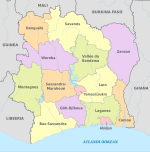|
Districts of Ivory Coast
The districts of Ivory Coast (French: districts de Côte d’Ivoire) are the first-level administrative subdivisions of the country. The districts were created in 2011 in an effort to further decentralise the state.[1][2] There are 14 autonomous districts. Except for the two autonomous districts around the cities of Yamoussoukro and Abidjan, the remaining 12 autonomous districts are further subdivided into 31 regions, which are further subdivided into 108 third-level subdivisions, the departments (French: départements). Departments are subdivided into 510 sub-prefectures (French: sous-préfectures). The lowest level of administrative organisation, which exist in limited numbers, is the commune. Although they are not divided into regions, the autonomous districts of Abidjan and Yamoussoukro do contain departments, sub-prefectures, and communes. Governance and purposeEach district is headed by a governor, who is appointed by the council of ministers (cabinet) of the national government.[3][4] Districts have been given four primary responsibilities:[3]
List of districts The following is the list of districts, district capitals and each district's regions
2011 administrative subdivision changes Prior to September 2011, Ivory Coast's first-level administrative subdivisions were 19 regions. In 2011, the regions were reorganized into the 14 districts (12 regular districts and 2 autonomous districts).[1][2] In 2014, the districts were abolished except for the two autonomous districts of Abidjan and Yamoussoukro. Then in 2021 the former districts were reinstated as autonomous districts.[7] The following is a summary of how the districts were constructed from the former regions:
See also
References
|
|||||||||||||||||||||||||||||||||||||||||||||||||||||||||||||||||||||||||||||||||||||||||||||||||||||||||||||||||||||||||||||||||||||||||||||||||||||||||||||||||||||||||||||||||||||||||||||||||||||||||


